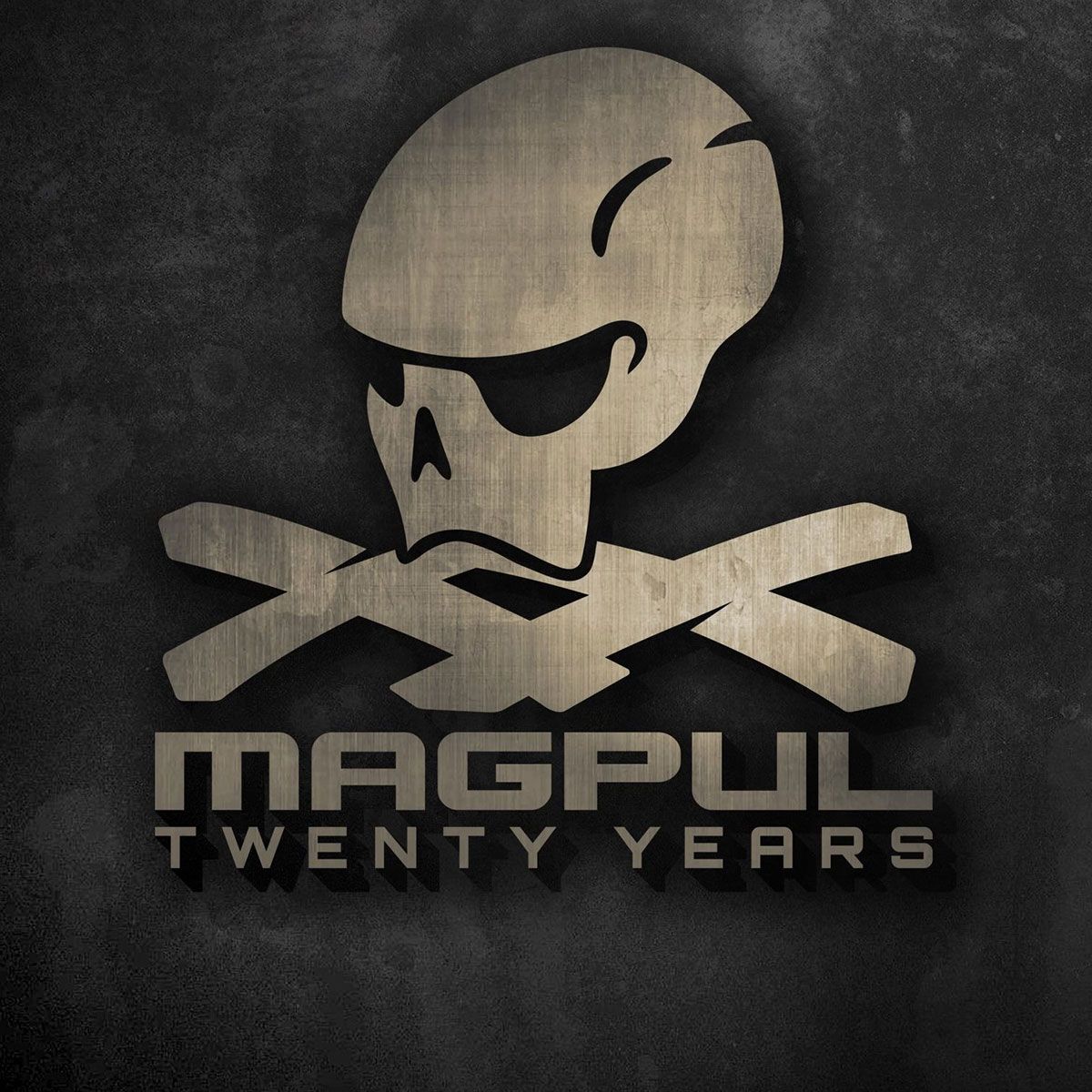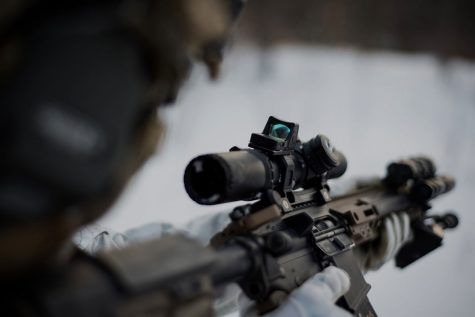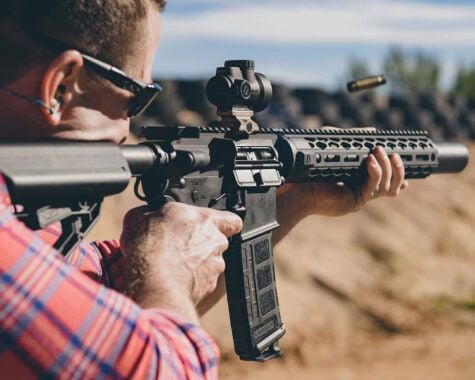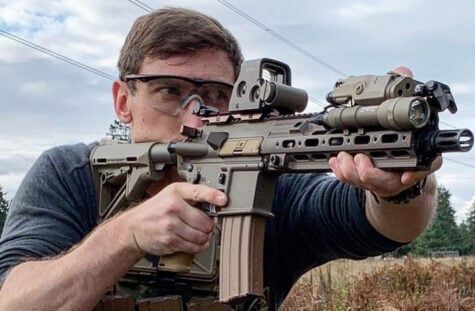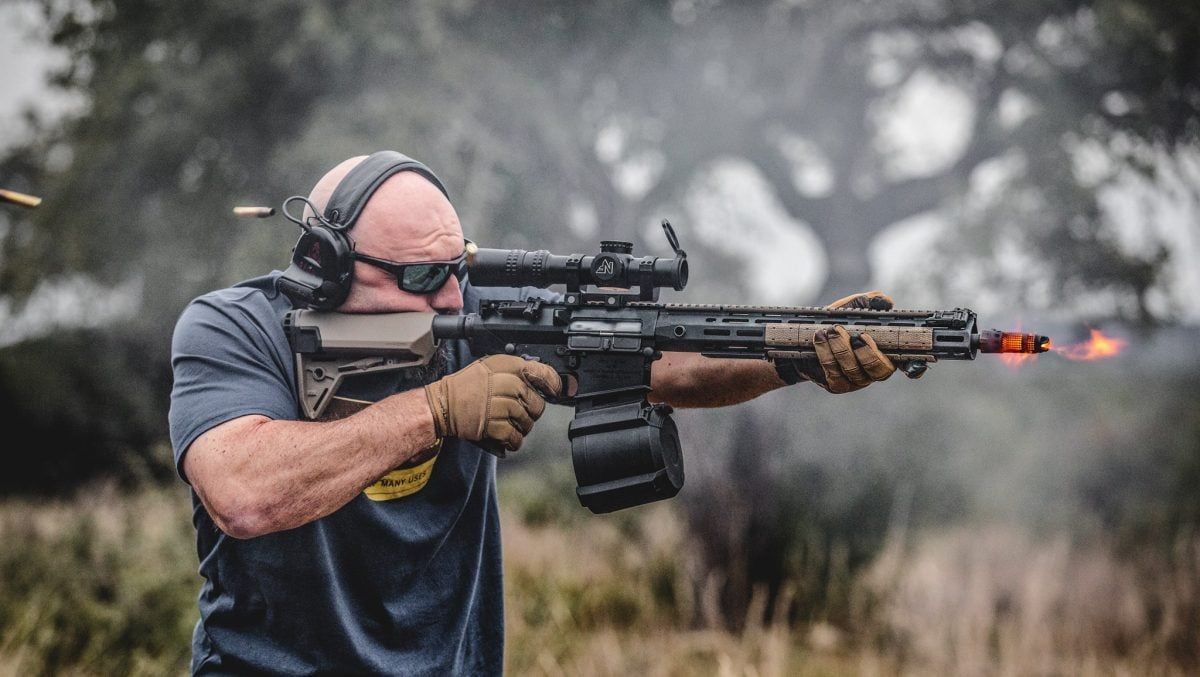
With Magpul currently celebrating its 20th anniversary, we felt it was a perfect time to touch base with Duane Liptak, Executive Vice President of Magpul Industries Corp. We wanted to discuss how the company has helped push the AR forward. We also wanted to chat about Duane’s background, his role at the National Rifle Association, and some of his current favorite AR builds.
Q: Duane, can we start with your background, and how that led to you being an NRA board member?
Duane Liptak, Magpul: I was born in a very rural area in Pennsylvania, and my interest in firearms started early. I was shooting at four or five, hunting and beginning to learn how to work on guns at 12. I had my first paid instructing and gunsmithing job at 17, shooting as a sponsored USPSA competitor, as well. After college, I enlisted in the Marine Corps as an infantryman, then swapped over to become an F/A-18 pilot as an officer, with a close to three-year stint in MARSOC in between flying tours.

The NRA had always been part of my life, as my father was a member, and I was a member from a very young age, becoming a life member in 2006, and now a benefactor member.
I was always a believer in freedom and the Russian menace and communism were the enemy. I was a Reagan-era kid, through and through. The NRA fought for one of the freedoms that I hold most dear, and that was most in danger of disappearing.
If you’ve never dealt with three-day Brady Bill waiting periods, the challenges of getting a “may issue” concealed carry permit, the complications of carry prior to pre-emption laws and reciprocity, or lived through the ’94 ban, you may not appreciate that we’ve gained some ground back. Not enough, though.
After my stint in the Marine Corps, my first job out was with Brownells, and they’ve always been big NRA supporters. From there, I got involved with the Training and Education committee, continuing after I moved to Magpul. After a few more committee assignments, I saw some things that I would like to change in the organization, and I wanted a vote in those efforts, so I ran for the Board.
“fix what needs fixing, keep what works, and move on”
There are a lot of things swirling around about the NRA right now. Some are exaggerations and some actually are real concerns for me, but they don’t shake my faith in what the organization is there for and what it is and can be. There are a lot of things that I unfortunately can’t share that might answer some of the concerns that people have, which is frustrating. Other things…we are certainly paying attention to them, and that’s all I can say.
But, the bottom line is that we need to have a strong NRA going into 2020, or the cause of firearms ownership and the 2nd Amendment will be in far greater jeopardy than ever, and the NRA is the only organization that has the capability to do what needs to be done. I’d like to fix what needs fixing, keep what works, and move on unified for the sake of the nation.

Q: Moving on to your time at Magpul, can you talk about not compromising when it comes to quality, but also not compromising as a company? Magpul leaving Colorado as an example…
Duane Liptak, Magpul: Quality and our QA/QC programs are something we take great pride in. The challenge increases exponentially when you go from making hundreds to making thousands, and from thousands to millions of any item, but we have a great quality shop. The bottom line is we work our processes, our DFM capabilities, and our vendors in a way that our reject rates are infinitesimally small, even with multiple points of inspection and gaging of raw parts and finished assemblies.
Testing Infrastructure
We have a rather robust testing infrastructure, and we destroy more products in a given year in the name of quality management testing than many companies make in their entire production. People trust that our products will work, and we have put a lot of effort into developing that trust. No one is completely perfect…but we have a track record we’re very proud of at any level, and especially given the volume of product we put out.
Duane Liptak on Magpul’s Core Identity
With gun rights, that’s part of the company’s core identity. Liberty, freedom, Randian economics—those ideas have been present since the founding. Yes, supporting the 2nd Amendment is important to the business side of things, but individual liberties are something we hold more sacred than pure financial success. It certainly would have been cheaper to stay put and just deal with the new laws. We were just about to sign documents to break ground on a new Colorado facility that we had planned for many months when the bill was introduced.
We fought, and despite our best efforts, the politicians didn’t want to hear the people. They heard during the recalls afterwards, though. We still have a design and engineering facility in Colorado, as we said we’d stay involved and not completely abandon the fight in the state, but it’s getting harder and harder to fight the tide there. We would love to turn things around for everyone still there.
Duane Liptak on The Nanny State and Bad Laws
Colorado is a beautiful state, with a lot of salt of the earth people. Too many have brought a nanny state mentality with them that has done nothing to increase safety, and our best bet at getting the state back is now likely through SCOTUS and some of the cases on mag bans, AWBs, and other topics making their way there, courtesy of the NRA and others, now that the court is more favorable. The latest injustice is Red Flag laws. Red Flag laws are terrible, need to be fought wherever they are proposed, and will hopefully be addressed properly in the courts sooner rather than later.
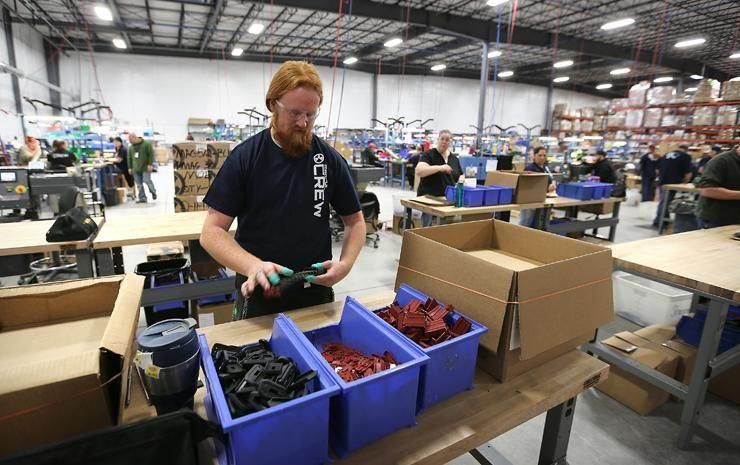
The main Magpul manufacturing operation in Wyoming and the headquarters in Texas are fantastic, and both states have been very welcoming. The workforce and talent are amazing in both places. Between the two, they house the vast majority of our footprint and tax revenue, and we are glad that we made the move.
“We couldn’t afford to stay”
Although our operation is pretty significant, we had the capability to move it without it being disastrous for the business. Some manufacturing businesses may have larger challenges and just can’t afford to move. From a personal and ideological perspective, we couldn’t afford to stay.
Q: Can you talk about your experiences over the years with the AR-15, how your perceptions of it have changed or stayed the same?
Duane Liptak, Magpul: I turned 18 in 1992, and was paying for school. As a pistol competitor primarily, I shot ARs, I worked on ARs, but the options were just more limited then, and I had other guns on my brain. I read too much Cooper, perhaps, and liked .45 and .308 battle rifles, and I wasn’t intensely into the AR at the time. I was more of a roller-delayed blowback fan, an affection I have never lost.
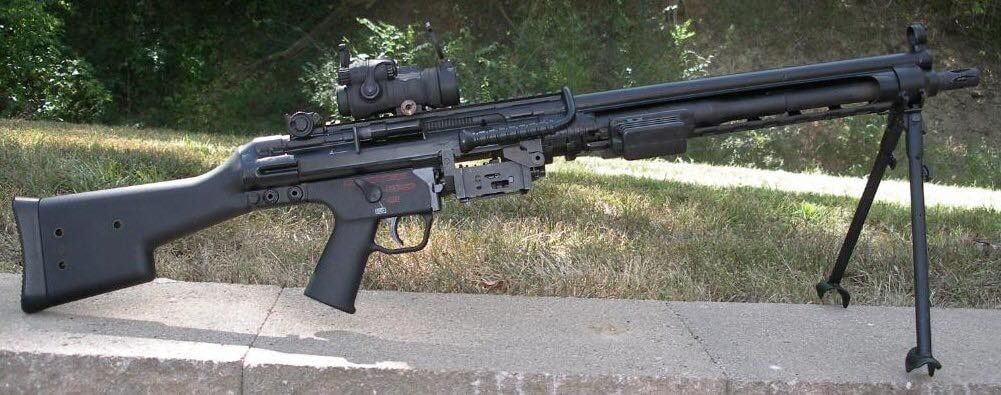
The AR market was much different then than it is now. I never could stomach the idea of buying a neutered rifle during the ban, and just held what I had. Not long after the ban expired, I was at the local gun shop buying. Then I grew comfortable with the AR after my time in the infantry and then again on the ground with MARSOC. There, I lamented some of the reliability issues I saw, and realized fairly quickly that build quality, gas ports, reciprocating mass, lubrication, and magazines were the biggest factors I was facing.
So, I looked for solutions. I was even an AK guy for a while—I still like the platform quite a bit. Then, I figured out that a properly built gun with the right gas port, chamber dimensions, and buffer weight worked really, really well when kept wet. Then I discovered PMAGs. Not long after that, I was working at Magpul.
“The greatest thing about the AR to me…”
The GEN M3 is at 31,000+ rounds between mag related stoppages and 12,000+ rounds between stoppages for any cause in third party testing now, so it’s hard to argue that the AR isn’t pretty hard to beat when done right and fed properly. The greatest thing about the AR to me, apart from system reliability, is the fact that it’s designed to be armorer/builder friendly.
Q: You had worked on ARs in the past, do you still enjoy tinkering and building today?
Duane Liptak, Magpul: I’m a tinkerer by nature, and the AR is ideally suited to that. And, for a while…it was hard to find guns in the exact configurations I wanted, but I could build anything, which is great. Now, there are more and more companies producing great guns in almost every configuration imaginable, but I’m still a builder…I have far more builds than factory guns.
Q: Can you discuss Magpul’s role in changing the AR platform for the better? Not just from a product perspective but from a mindset perspective with training materials that were offered?
Duane Liptak, Magpul: From a product perspective, it was a matter of looking at the rifle as an extension of will rather than as a military procurement item. “Best cost to the government” is not a great motivator of progress or ergonomic suitability for best performance, and with a few exceptions, that was usually the standard applied to AR platform improvements up to the expiration of the ’94 ban.
With everything we do, it’s usually a matter of trying to figure out where potential problems exist, and seeing if we can solve them in a way that makes the system work together more effectively and reliably for the shooter, with performance in the harshest conditions as a given.

Duane Liptak on Turning Owners into Enthusiasts
From a mindset perspective, our founder understood that the way to create success for the platform was to turn owners into enthusiasts–to get people out and using their rifles. By creating a training program with an attainable aspiration quality, showing real people progressing in their skill development in front of the eyes of the viewer, the idea of training was more accessible and less daunting. A trained populace, “well regulated”, if you will, is at the heart of the 2nd Amendment.
The more trained people we have that are enthusiastic about the platform and about riflecraft in general, the stronger we are as a nation. The more able we are to fight against future infringements. Those us who lived through the ’94 ban don’t ever want to see that nonsense again.
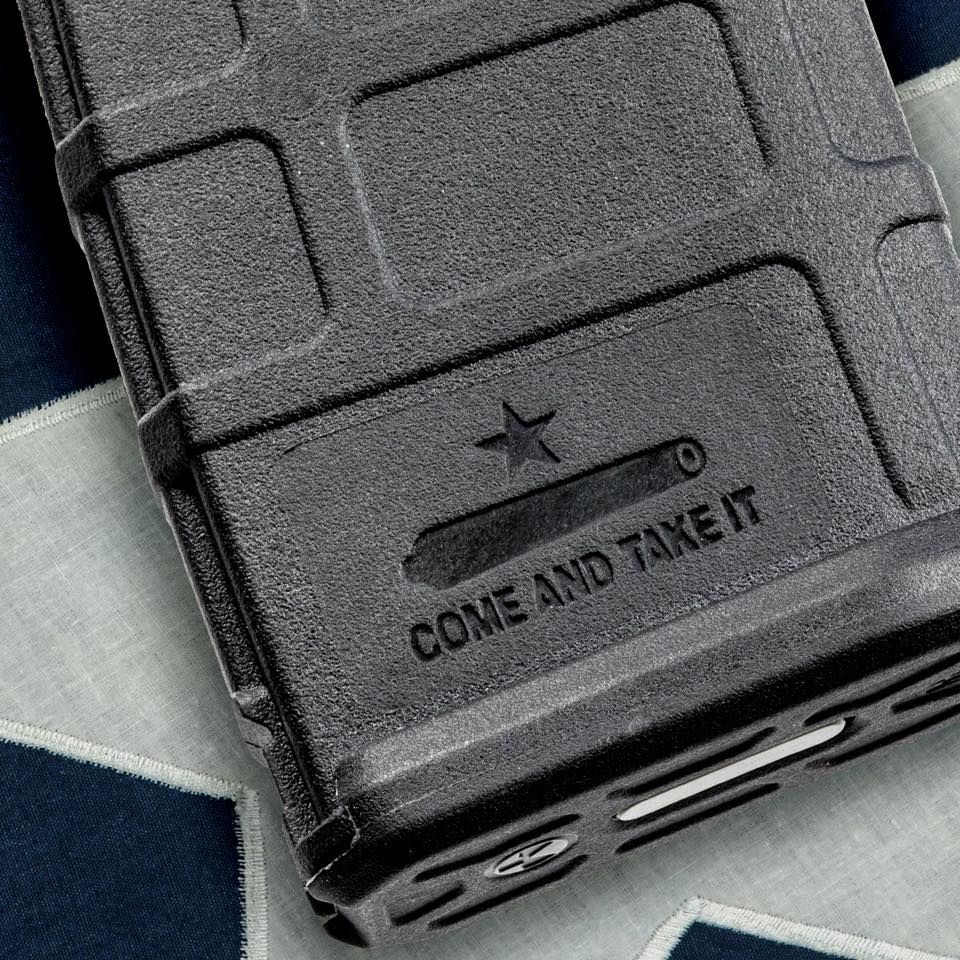
Q: Can you talk about the company culture at Magpul? I’ve heard it said recently that can tell a lot about a company by the quality of its products. You can’t fake it…
Duane Liptak, Magpul: There’s a drive here, for sure. We have a lean team, and it doesn’t operate well with unmotivated people in seats, so it requires a level of intensity. I’ll also admit that at times, it requires some faith. As in being lean, sometimes we get caught up in what’s at hand, and we don’t share as much information as we should internally.
We want people of passion inside the walls. Shooting, on some level, absolutely…but we also appreciate passion and intensity for anything. Cars, motorcycles, electronics, machining, archery, hunting, fitness, etc., all manner of things can have some relevance, but we’ve found that people who are passionate about something usually bring that level of intensity and creativity to their roles here.
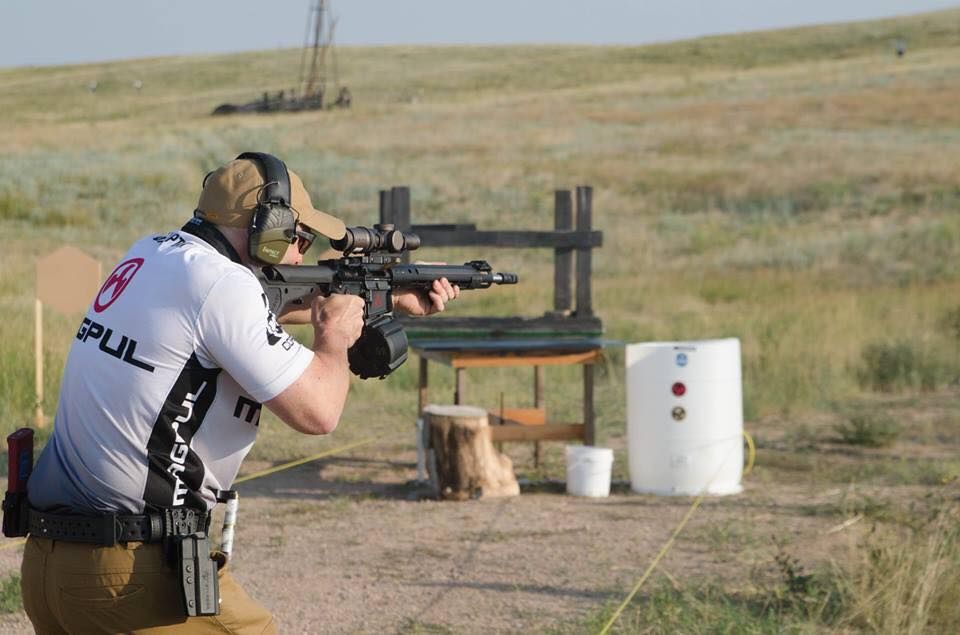
Of course, the product focused roles are heavy into the shooting side of everything. But we also do range trips with marketing, accounting, and other areas from time to time, as it’s important to who we are that everyone appreciates what we are making. We don’t do it in an organized fashion as much as we should, but we try.
Q: How does Magpul try to lead and identify problems before everyone else?
Duane Liptak, Magpul: We’re constantly looking for problems to solve. We shoot, we compete, we have a bunch of prior and current military users on staff and deep contacts with everyone that’s still in the fight. We’re not always the first to identify them, but we’re always looking for input and problems that others have found so we can try to solve them.
The solution is what we live for, and what drives us. I wish we could tackle everything we come across, but we do have to make a business case for what we choose to tackle.
Q: Do you think the AR-15 has peaked? If so, any idea what’s next?
Duane Liptak, Magpul: I will say that the AR has certainly entered a period of…let’s call it “mass appreciation and availability.” With any mature market, there are some commoditizing forces. We see a lot of lower-end items competing for space in a crowded room from those hoping to save a few pennies.
We also see some of the highest quality firearms and components available in the entire history of the gun. The success and size of the market for ARs is what has fed both of those things.
Duane Liptak on AR Advancement and Innovation
But, are we done with advancements? No. There’s still a lot of room. New calibers, new materials, functional and ergonomic improvements, PCCs—all these things continue to march. There are still guns I want to build and want to buy, and I’m certainly not the only one. So there’s a lot of runway left in the AR.
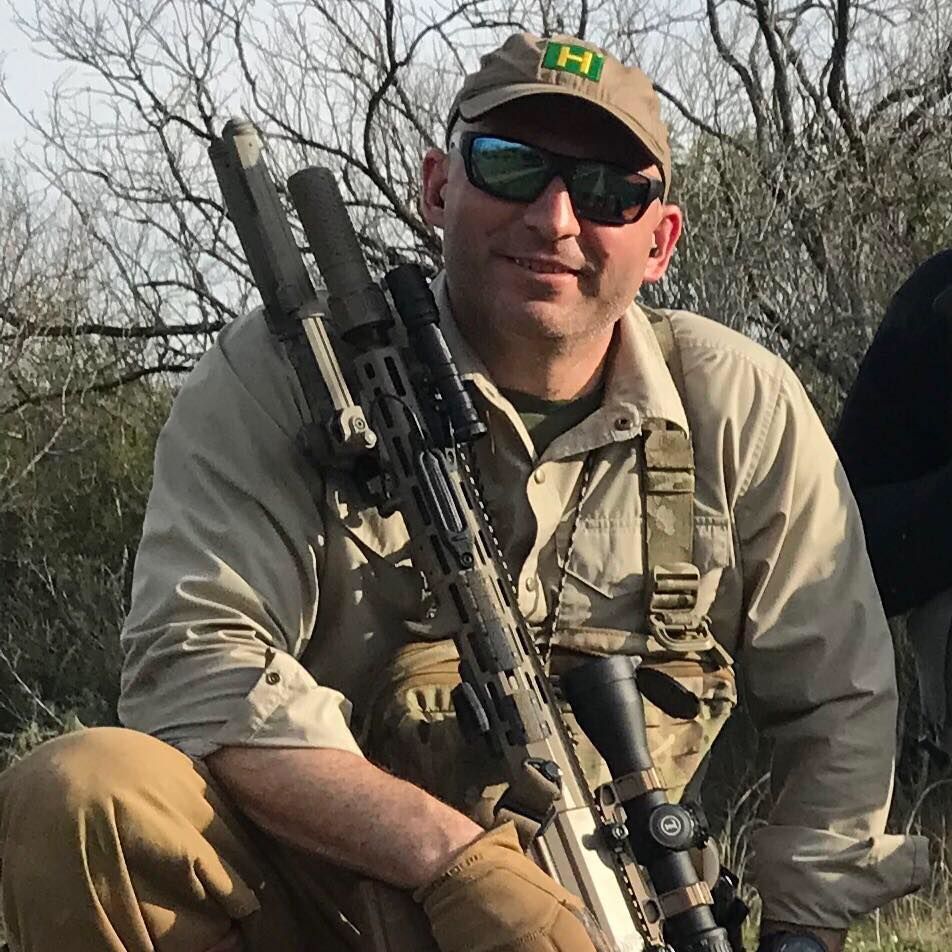
Q: Are there firearms out there today that intrigue you?
Duane Liptak, Magpul: I often have divergence into various other platforms. It’s what keeps things fresh and keeps me from looking at everything from the same paradigm. I still love roller guns. I still love AKs. Regularly I wander off into bolt guns, SAA’s, blackpowder cartridge Sharps rifles, and even flintlocks.
I like guns, period, because they demonstrate man’s ingenuity when solving for problems that can truly be life or death. They are the symbol of individual liberty, and have played a pivotal role in world history. They are just as relevant for the personal safety of the private citizen today.
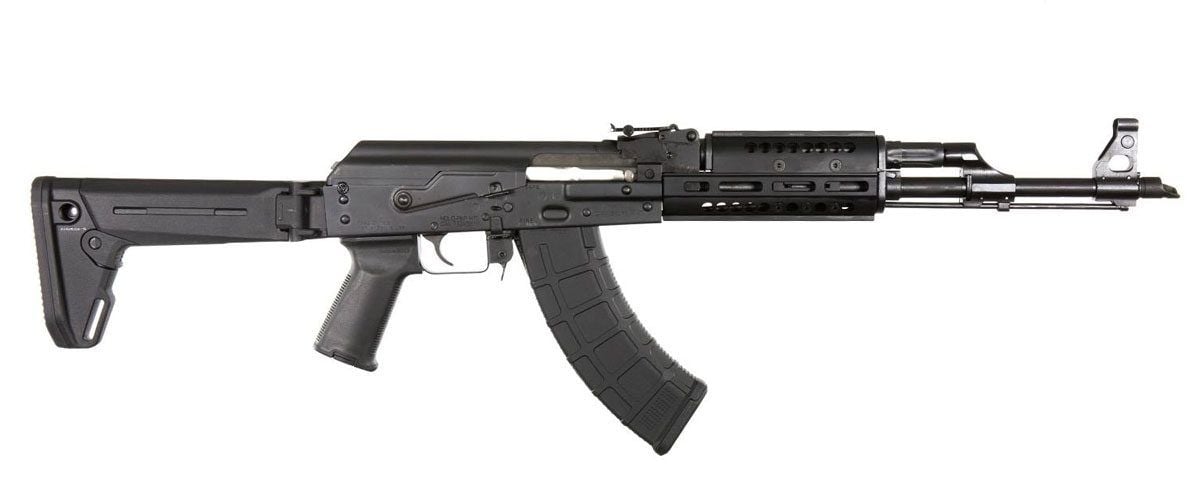
As far as new platforms, there are a lot of things that interest me from an academic as well as functional perspective. It’s going to be hard to dethrone the AR, however. It’s so ubiquitous, so versatile, and now so relatively inexpensive that it will be hard to develop a new platform to truly ever replace it in the civilian market.
I like guns, period, because they demonstrate man’s ingenuity when solving for problems that can truly be life or death. They are the symbol of individual liberty, and have played a pivotal role in world history, and are just as relevant for the personal safety of the private citizen today.
Duane Liptak
Duane Liptak on a Return to Regulatory & Legal Freedom
What I’d love to see is a true return to regulatory and legal freedom, and I think that would open up a lot as far as new platform development. It’s a crazy world to be running a business in right now, when certain politicians are trying to both remove access to financial services and make everything we produce illegal, plus there are regulations that drive product design and implementation unnaturally. Those hurt the market, of course. As a nation, we’ve fought through that, and there are a lot of us flourishing despite their efforts.
The political reality makes it hard to imagine getting legislative support for something like repealing the NFA and getting rid of the entire regulatory mess of 922, import bans, and other infringements, but that’s what I’d like to see, and I think what the industry would come up with would be amazing. If we end up with a 6-3 SCOTUS someday, it would be worth a run at trying to get that done through the judiciary. I want mail-order belt-fed suppressed machine guns.
Q: What is your preferred AR set up today?
Duane Liptak, Magpul: That depends on the use or purpose. The ARs that see the most action in my safe are the following:
10.5” SBR on Aero Precision receiver, Colt BCG and LPK, FN CHF barrel, Geissele M-LOK rail, Geissele SSA-E, Law Tactical folder, Aimpoint T-2, Saker K suppressor, Magpul Suppressor cover, SL Stock, K2 grip, MS-1 sling, and BE Meyers MAWL is my home defense/structures gun.
14.5” Hodge Mod 1 Titanium Recce with Vortex Gen 2 Razor 1-6x MRAD. Surefire Warcomp pinned and welded, SOCOM RC2 suppressor. Larue trigger. K2+ grip, SL-S stock, which is my favorite of our line right now. This is my general “go-to” all around gun.
18” 3-gun rifle, Aero Receivers, JP low mass carrier and adjustable gas block, White Oak stretch gas .223 Wylde barrel, Geissele hi-speed trigger, Vortex Gen II Razor JM-1, Surefire brake, ALG rail, custom buffer setup, UBR Gen 2 Stock, K2+ grip.
16” Knight’s Armament SR-25 APC. Leupold Mk6 3-18x, DBAL, KAC QD CQB can, with Magpul bipod and our tripod adapter. Geissele SD-E trigger. This gets used quite a bit for night hunting with a PVS-26/30.
I also have a 16” SPR build with a Proof barrel that gets a decent amount of love.

Q: Are there things that people should know or questions that don’t get asked enough?
Duane Liptak, Magpul: Don’t ever give up learning. There are a lot of folks that will degrade a hobbyist who builds their own rifles, and that’s not constructive from a grand perspective. Yes…your first attempt may not pass muster as “duty grade” for reliability or durability, especially if the parts choice was based on budget items to help learn the system.
Yes, some components are indeed, not “just as good as” others—and some are. But, you have to learn somewhere, as long as you’re not placing an undue amount of dependence on early efforts until you’re sure of your components and your processes.
if you use good parts in a well thought out system and truly assemble them correctly, you can easily end up with a very capable tool that you’ve built yourself, and there’s nothing more American than that.
Duane Liptak
“Getting Some Builds Under Your Belt”
There are plenty of reasons and purposes for ARs, and lots of uses to which even early efforts can be well suited. And, some folks will get it more right from the start, especially if doing it under instruction of a mentor. The important thing is that by learning to do things right—from good sources—and by getting some builds under your belt, that’s how you become capable of assembling a truly good rifle.
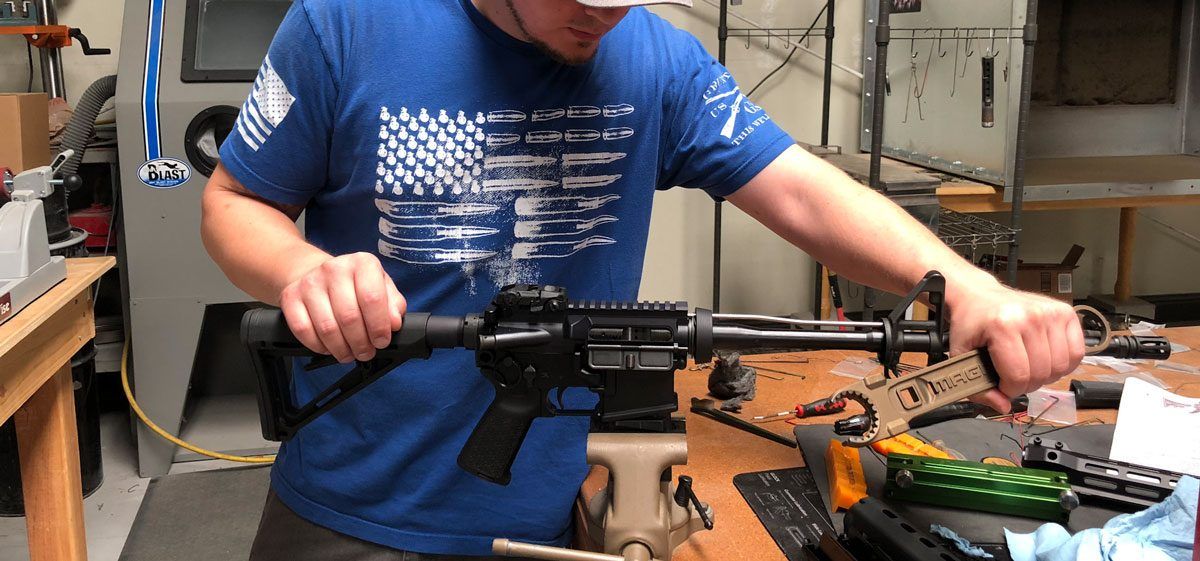
Appreciating Mastery
Understanding your tools at a level of mastery is an independence that helps you to make what you want, and to appreciate when manufacturers do things right. Yes…in the long run, this is absolutely a more expensive path to arrive at a “solid” rifle, and quality manufacturers have great advantages in turning out a good, well tested system.
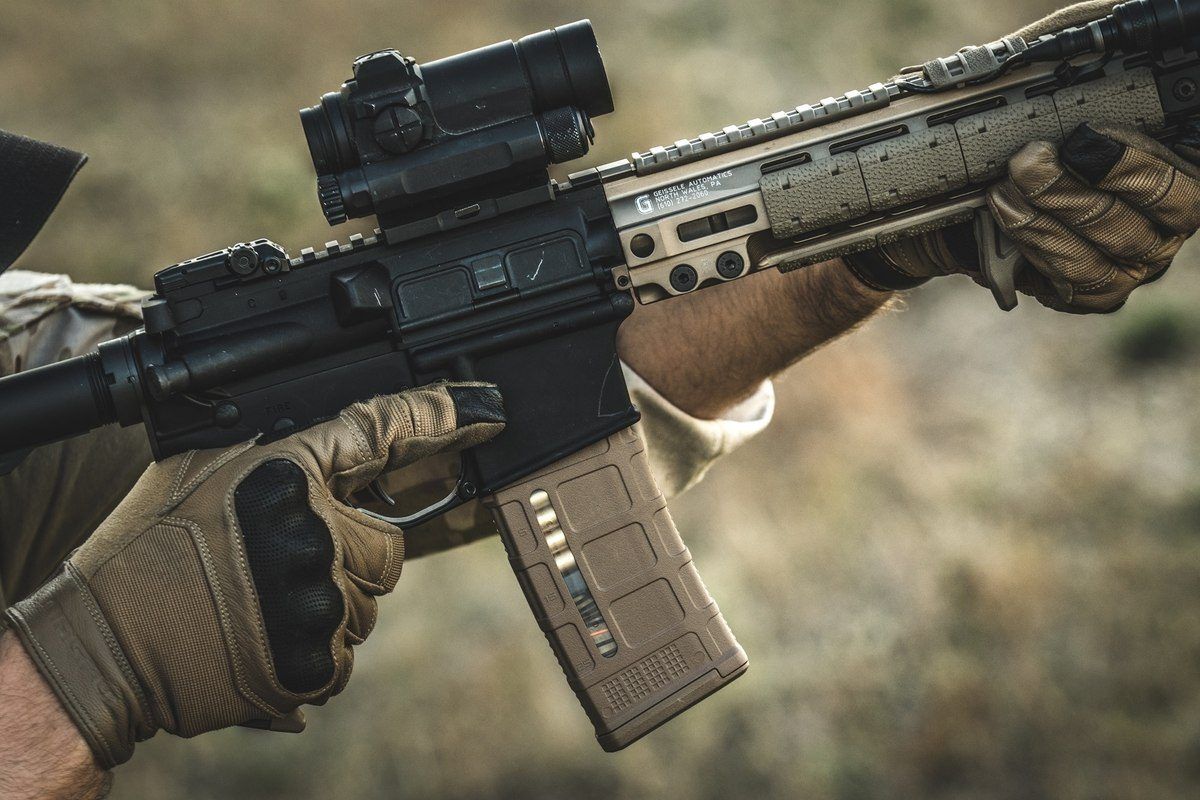
I’d still absolutely encourage using a gun built by a reputable manufacturer for defensive purposes for most people. Some just won’t be able to put enough time into learning or have the opportunity to gain the experience—and if you do…don’t keep track of how much it costs you, because it will likely be depressing.
But, if you use good parts in a well thought out system and truly assemble them correctly, you can easily end up with a very capable tool that you’ve built yourself…and there’s nothing more American than that.
###
